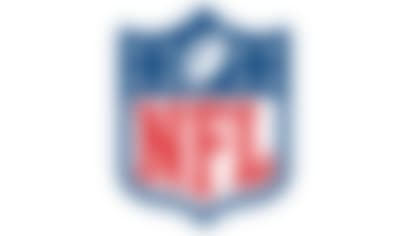The return of preseason action can only mean one thing: Prediction season is here.
Well, actually, I am kind of a stickler for calling the output of my models projections rather than predictions. The distinction, to me, is that I've tried to eliminate as many biases as possible from my mathematical frameworks, whereas calling something a prediction makes it sound like speculative judgments were involved on some level. The names and numbers you see below are the players who rank first in each category based on their projected performance. There are also some extra informational nuggets on interesting results regarding players who, though they don't necessarily rank first, figure to produce an output that is interesting for fantasy or team-win-total purposes.
As we get closer to the regular season, I'll update my models, and these numbers could be adjusted, but let me know if you agree or disagree with my projections -- and let me know if you're predicting this, or if you've created a model to project your own stats leaders! You can hit me up on Twitter: @cfrelund.
Passing yards: Kansas City Chiefs QB Patrick Mahomes (4,702).Drew Brees is the only player in NFL history to throw for 5,000 yards in consecutive seasons, accomplishing that feat from 2011 through '13. Complementary football is influential in terms of forecasting quarterback play. For example, the 2012 Saints ranked last in defensive yards allowed per game (440.1) while also giving up the second-most points per game (28.4) -- and that season, Brees averaged 323.6 passing yards per game and threw for 43 touchdowns (ranking first in both categories). The decrease in Mahomes' passing yardage in my projection (he threw for 5,097 in 2018) stems partially from the fact that the Chiefs' defense is forecasted to significantly improve from last season, when Kansas City allowed 405.5 yards per game (second-worst in the NFL) and 49 offensive touchdowns (tied for 28th).
Bonus: My model likes Eagles quarterback Carson Wentz to throw for 4,224 yards this season. Wentz has yet to top 4,000 yards in a season, in large part because he missed eight regular-season games in the past two seasons, but my model has high confidence in him topping 4,200 in 2019.
Passing touchdowns: Kansas City Chiefs QB Patrick Mahomes (37). This may seem like a big dip from last season, when Mahomes threw for 50 TDs, but 37 would have topped the League in 2017 (when Russell Wilson led with 34) and 2015 (when Tom Brady led with 36). Similar to the passing-yardage projection, Mahomes' touchdown total is projected to decrease because of an improved Chiefs defense. Think of it like this: Last season, the Chiefs allowed the most yards per game on first down (208.8) and the most 10-play drives (41). They had the most 10-play defensive drives that resulted in a touchdown (22), as well. Thus, Mahomes and the offense were asked to score often (which they did, at a league-high rate of 4.1 touchdowns per game), and quickly. My model projects the defense will do a better job of keeping opponents out of the end zone this season, meaning the strategy of play-calling can reflect more control and necessitate fewer touchdowns. Don't worry: K.C. will still be electric, just a little more strategic.
Rushing yards: Dallas Cowboys RB Ezekiel Elliott (1,324). This number reflects a 16-game season from Elliott, who is currently sitting out Cowboys camp as part of a push for a new contract. I do not expect Zeke to miss any games. However, I have him slated to finish with 25-plus more rushing attempts than the next-closest back, so even if Elliott were to miss Week 1, he would still project to pace the NFL. If he were to miss a significant amount of time, then my model would shift to Bengals running back Joe Mixon. One interesting note is that after receiver Amari Cooper joined the team via trade last October, Elliott's rushing average increased, from 4.56 yards per rush in Elliott's first eight games to 4.86 yards per rush in Games 9 through 15 (he didn't play in the team's regular-season finale). Elliott's ability to capitalize off his excellent O-line, combined with more favorable rushing conditions (a.k.a., fewer stacked boxes) due to the improvement in Dallas' pass-catching options drives a strong forward-looking projection.
Receptions: New Orleans Saints WR Michael Thomas (111). Last season, Thomas caught 125 of the 147 passes Drew Brees threw his way. This means he had an 85 percent catch rate, the highest of any receiver and 11 percent-plus more efficient than the next-closest wideout (among those who logged at least 100 targets). The volume of targets Thomas projects to see again this season means he's unlikely to sustain this rate, but the type of offense and game scripts that are projected to characterize the Saints' games, along with the types of routes on which Thomas is forecasted to be targeted, means a catch percentage in the mid-to-high 70s is very likely, which drives his ranking.
Bonus: I have Thomas slated for 11 touchdowns, which would mark the first time since he entered the NFL in 2016 that he reached double digits.
Receiving yards: Atlanta Falcons WR Julio Jones (1,512). No receiver was targeted more last season than Jones (170), and no receiver moved the chains on third down more (Jones logged 24 first downs on third down). Now factor in offensive coordinator Dirk Koetter, who returns to the role he held from 2012 through '14, designing plays for him! It's hard to overstate how elite Jones is when it comes to helping his team earn first downs and touchdowns, even if he's not getting in the end zone as much as fantasy owners might like. This season, my model forecasts eight touchdowns for Jones.
Bonus:Odell Beckham Jr. is projected to finish with 1,355 receiving yards. The new Brown and former Giant has only played all 16 games in a season once (2016) since entering the NFL in 2014. While his projection here does not match the 1,450-yard season Beckham had in 2015, this number tops his totals over the past two seasons combined.
Total touches: Dallas Cowboys RB Ezekiel Elliott (388). Elliott's 381 touches last season topped the NFL -- and he amassed them despite playing just 15 games. This season, my model projects an average of 24.25 touches per game. This is lower than his average from last season (25.4) and his average over the second half of 2018 (28). I add this because I want to make sure to show that after Cooper joined the team, Zeke's touches actually went up. Unlike what I wrote in the above blurb projecting Elliott to lead the NFL in rushing, Zeke will not be the leader in touches if he even misses one game, as my model projects Giants back Saquon Barkley to carry nearly the same workload as Zeke.
Bonus: My model forecasts Ravens quarterback Lamar Jackson to rush 189 times! This would easily clear the single-season mark for quarterbacks, which Jackson set in 2018 (147).
Total touchdowns: New York Giants RB Saquon Barkley (14). I'd just like to note here that my model creates fractional touchdown projections, which is how Barkley (14.2) slightly edged out Saints running back Alvin Kamara (14.1). Barkley's projection is not surprising when you glance at New York's depth chart, where receiver Golden Tate is facing a four-game suspension for PEDs, Sterling Shepard is dealing with a fractured thumb and Corey Colemansuffered a torn ACL.
Bonus:Texans receiver DeAndre Hopkins has scored 11 or more touchdowns in three of his past four seasons, and he's only missed one game in his career. Last season, he also earned the most receiving first downs among wide receivers in the league (81). My model has him earning 11 or more touchdowns in 78 percent of the simulations. That's a monster level of confidence.
Sacks: Los Angeles Rams DT Aaron Donald (18). Fun fact: Donald, who paced the NFL last season with 20.5 sacks, would be the first player to lead the NFL in sacks in consecutive seasons since Reggie White in 1987-88. That's great company, no? I use computer vision to track pressures (and specifically pressures that disrupt passes, a.k.a. defenders coming within 5 feet of an opposing quarterback in a way that influenced the pass), and Donald is able to enter that 5-foot halo about 0.5 seconds faster than the next-fastest interior defender.
Interceptions: Jacksonville Jaguars CB Jalen Ramsey (7). The best situations in which to earn interceptions are when defenses face passes in unfavorable down-and-distance situations. Improving on offense, as the Jags are forecasted to do with new quarterback Nick Foles, means there is a greatly increased chance the defense will operate more like Jacksonville's Pressure and Turnover Machine of 2017. Predictively, Ramsey wants a hefty raise in his next contract, and the desire to prove his worth may be an extra intrinsic motivator that I can't exactly model. (See my hard-hitting mathematical breakdown here.)
Rookie touchdown leader: Oakland Raiders RB Josh Jacobs (7). Between projected snaps, rushes/targets, efficiency and scoring opportunities, Jacobs edges out Bears running back David Montgomery in scoring by a small margin. If you're considering either of these guys in fantasy, (and you should be, depending on where you're thinking about drafting them), factor in a better O-line for the Bear and more touches in the red zone for the Raider.
Rookie sacks: Jacksonville Jaguars DE Josh Allen (10). Jacksonville's defensive front projects to be a nightmare for opposing offenses, especially on the edges. While the projection landed on 10 for Allen, it wouldn't be unreasonable to think he could match Bradley Chubb's sack total of 12 in 2018, which paced rookies last season. When I queried the model as to how often Allen collects 12 or more sacks, the model returned 22 percent. That may seem small, but no other rookie has more than a 15 percent return of 12-plus sacks in my model.
Follow Cynthia Frelund on Twitter @cfrelund.




